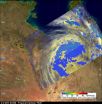(Press-News.org) When a laboratory rat learns how to reach for and grab a food pellet – a pretty complex and unnatural act for a rodent – the acquired knowledge significantly alters the structure of the specific brain cells involved, which sprout a whopping 22 percent more dendritic spines connecting them to other motor neurons.
The finding, published in the journal Proceedings of the National Academy of Sciences by Mark H. Tuszynski, MD, PhD, professor of neurosciences and colleagues at the University of California, San Diego School of Medicine, underscores the brain's remarkable ability to physically change as it learns (not just in rats, but presumably in humans too), but also reveals that the effect is surprisingly restricted to the network of neurons actually involved in the learning.
"I think it's fair to say that in the past it was generally believed that a whole cortical region would change when learning occurred in that region, that a large group of neurons would show a fairly modest change in overall structure," said Tuszynski, who is also director of the Center for Neural Repair at the UC San Diego and a neurologist at the Veterans Affairs San Diego Health System.
"Our findings show that this is not the case. Instead, a very small number of neurons specifically activated by learning show an expansion of structure that's both surprisingly extensive – there's a dramatic increase in the size and complexity of the affected neurons – and yet highly restricted to a small subset of cells. And all of this structural plasticity is occurring in the context of normal learning, which highlights just how changeable the adult brain is as a part of its normal biology."
Tuszynski said the new work improves science's basic understanding of how the brain learns. "This tells us that learning may be mediated by relatively few cells, but that these few cells exhibit a substantial or extensive change in structure." Notably, the impacted cells in the rat study were not clustered together, but widely distributed over the motor cortex of the rat brain, suggesting that learned behaviors create expansive networks of distant cells.
Whether these new connections and changes are permanent is the subject of continuing research. For a rat, reaching for and grasping food is a learned behavior that takes time and repetition to master, not unlike a person learning to ride a bike or play the piano. If the behavior isn't regularly practiced, it becomes rusty, though it may be later resumed and remembered.
"This seems to be a 'hard-wired' form of memory," said Tuszynski. "We were curious whether we could find evidence of hard-wiring as part of learning in animal brains. We designed this study and our original hypothesis seems to be confirmed.
"Whether this physically represents the formation of long-term memory is hard to say" Tuszynski said, explaining that the data are correlative. "The rats learn, and we know that the learning is mediated by the small set of cells we studied. We know that adjacent cells in the cortex, which are not required to learn the new task, do not show the structural change. So presumably the structural change is occurring only in the learning neurons, and the learning would likely not occur without the structural change."
He added that in order to determine whether the structural change is necessary for the learning to occur, scientists would need to block the expansion in spines and then observe a failure to learn. "Yet the inference is quite strong that structural change is necessary for the learning to occur."
Tuszynski said it remains to be seen how the brain changes in other types of learning, such as language-based knowledge or arithmetic-type learning.
"Types of memory that require much repetition for learning – and that don't fade away easily – likely use this modification of (dendritic) structure to accomplish the learning," he said. "Other forms of memory that are not so hard to establish – and which fade more rapidly – may not involve such extensive structural changes. These are concepts that will be pursued in future studies."
INFORMATION:
Co-authors of the study are Ling Wang, James M. Conner and Jessica Rickert, all in the Department of Neurosciences, UC San Diego.
The research was supported by National Institutes of Health Grant AG10435 and by the Dr. Miriam and Sheldon G. Adelson Medical Research Foundation.
Learning causes structural changes in affected neurons
2011-02-04
ELSE PRESS RELEASES FROM THIS DATE:
'Tall order' sunlight-to-hydrogen system works, neutron analysis confirms
2011-02-04
OAK RIDGE, Tenn. Feb. 3, 2011 -- Researchers at the Department of Energy's Oak Ridge National Laboratory have developed a biohybrid photoconversion system -- based on the interaction of photosynthetic plant proteins with synthetic polymers -- that can convert visible light into hydrogen fuel.
Photosynthesis, the natural process carried out by plants, algae and some bacterial species, converts sunlight energy into chemical energy and sustains much of the life on earth. Researchers have long sought inspiration from photosynthesis to develop new materials to harness the ...
Loss of oyster reefs a global problem, but one with solutions
2011-02-04
(February 3, 2011) Those familiar with Chesapeake Bay know that its once-vast oyster population stands at a tiny fraction of its historical abundance. A new study by an international team including professor Mark Luckenbach of the Virginia Institute of Marine Science shows that the decline of oyster reefs is not just a local problem.
The team's global comparison of oyster reefs past and present shows that oyster reefs are at less than 10% of their prior abundance in 70% of the 144 bays studied, ranging from China to England to Australia to Brazil. Overall, they estimate ...
Future surgeons may use robotic nurse, 'gesture recognition'
2011-02-04
WEST LAFAYETTE, Ind. -- Surgeons of the future might use a system that recognizes hand gestures as commands to control a robotic scrub nurse or tell a computer to display medical images of the patient during an operation.
Both the hand-gesture recognition and robotic nurse innovations might help to reduce the length of surgeries and the potential for infection, said Juan Pablo Wachs, an assistant professor of industrial engineering at Purdue University.
The "vision-based hand gesture recognition" technology could have other applications, including the coordination of ...
Morning-after spike in ozone air pollution from Super Bowl XLV?
2011-02-04
WASHINGTON, Feb. 3, 2011 — Not even the most avid fans could notice, but those spectacular aerial images of a brightly-lit Cowboys Stadium during Sunday's Super Bowl XLV symbolize one of the hottest new pieces of scientific intelligence about air pollution:
Researchers have discovered — in a classic case of scientific serendipity — that the bright light from sports stadiums and urban street lights may boost daytime levels of ozone, a key air pollutant in many heavily populated areas. That's among the topics included in a broader article about the chemistry of air pollution ...
Scientists urge new research policies in wake of Gulf disaster
2011-02-04
CORVALLIS, Ore. – Scientists are having a difficult time gauging the recovery of marine species from the Deepwater Horizon oil spill in the Gulf of Mexico because they lack sufficient data about historical population size and the distribution, growth rates and reproduction rates of many species.
In a forum paper published this week in the journal Science, they call for a new research agenda that prioritizes systematic acquisition of baseline data for marine species.
"It is impossible to diagnose whether a species is recovering or floundering if you don't have good data ...
Oil in Gulf of Mexico: Biologists cite need for critical data to determine ecological consequences
2011-02-04
GAINESVILLE, Fla. — Twenty years after biologists attempted to determine the ecological damages to marine life from the Exxon Valdez oil spill, scientists dealing with the BP disaster find themselves with the same problem: the lack of critical data to determine the ecological consequences of human-induced environmental disasters, a University of Florida researcher said.
Writing in the Feb. 4 issue of the journal Science, Karen A. Bjorndal, a University of Florida biology professor and director of the Archie Carr Center for Sea Turtle Research, and other biologists said ...
New clue to lupus: Failed autoimmune suppression mechanism
2011-02-04
Bar Harbor, Maine — Researchers at Dana-Farber Cancer Institute in Cambridge, Mass., in collaboration with Jackson Laboratory scientists, have identified a regulatory defect that drives lupus.
Correcting the defect "may represent an effective therapeutic approach to systemic lupus erythematosus-like autoimmune disease," the researchers state in their research paper, published in the Proceedings of the National Academy of Sciences. The research team was led by Harvey Cantor, M.D., chair of the department of cancer immunology and AIDS at Dana-Farber, in collaboration with ...
Surprise hidden in Titan's smog: Cirrus-like clouds
2011-02-04
Every day is a bad-air day on Saturn's largest moon, Titan. Blanketed by haze far worse than any smog belched out in Los Angeles, Beijing or even Sherlock Holmes's London, the moon looks like a dirty orange ball. Described once as crude oil without the sulfur, the haze is made of tiny droplets of hydrocarbons with other, more noxious chemicals mixed in. Gunk.
Icky as it may sound, Titan is really the rarest of gems: the only moon in our solar system with an atmosphere worthy of a planet. This atmosphere comes complete with lightning, drizzle and occasionally a big, summer-downpour ...
NASA measuring Tropical Storm Yasi's inland rainfall from space
2011-02-04
Tropical Cyclone Yasi has continued moving through inland Queensland, Australia and has weakened to a tropical depression today. NASA and JAXA's TRMM satellite passed over Yasi as it continued to drop moderate to heavy rainfall.
On February 3 at 0300 UTC (Feb. 2 at 10 p.m. EST/1 p.m. Australia local time) Tropical cyclone Yasi continued over land as a tropical storm. Yasi's maximum sustained winds were near 60 knots (69 mph/111 kmh). It was moving west-southwest near 20 knots/23 mph/37 kmh). It was located about 200 miles (321 km) southwest of Cairns, Australia near ...
OHSU fixes complex heart problems without open-heart surgery
2011-02-04
PORTLAND, Ore. -- The pediatric cardiac team at Oregon Health & Science University Doernbecher Children's Hospital is the first in the region and one of a handful in the nation to implant a pulmonary heart valve without open-heart surgery.
To date, four patients have received the landmark valve in the OHSU Pediatric and Adult Congenital Cardiac Catheterization Lab. All reported immediate improvement in their energy level and stamina.
The device, called the Medtronic Melody® Transcatheter Pulmonary Valve, recently was approved by the Food and Drug Administration. The ...



